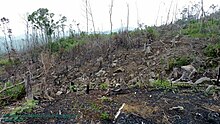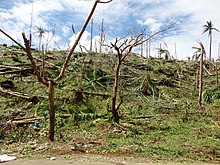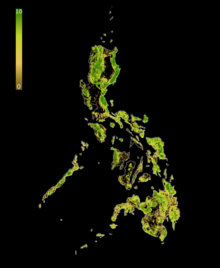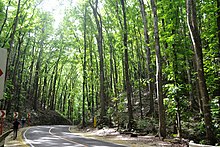Deforestation in the Philippines


As in other Southeast Asian countries, deforestation in the Philippines is a major environmental issue. Over the course of the 20th century, the forest cover of the country dropped from 70 percent down to 20 percent.[1] A 2010 land cover mapping by the National Mapping and Resource Information Authority (NAMRIA) revealed that the total forest cover of the Philippines is 6,839,718 hectares (68,397.18 km2) or 23% of the country's total area of 30,000,000 hectares (300,000 km2).[2] Rapid population growth, unregulated logging concessions especially during Ferdinand Marcos' regime, illegal logging and mining, and destructive typhoons have been cited as major reasons for deforestation in the country.
Deforestation affects biodiversity in the Philippines and has long-term negative impacts on the country's food production.[3] Deforestation in the country has also been associated with floods, soil erosion, deaths, and damage to property.[4]
To combat deforestation, the Philippine government has made efforts to preserve and restore forests through reforestation projects such as the National Greening Program. Legislation to protect existing forests have also been proposed and enacted, while non-governmental organizations, Indigenous communities, and the private sector conduct tree-planting activities in various parts of the country.
History
[edit]Colonial era deforestation
[edit]Data on forestry before 1946 has been sparse, reportedly due to an 1897 fire and World War II that destroyed Spanish and American records respectively. Around 90% of the Philippines, which had a population of less than a million, was forested in the 16th century during the early years of Spanish colonization. By the early era of the American colonization in 1903, this figure declined to 70% as the country's population grew to 7.6 million. After the Japanese occupation and World War II in 1950, forest cover in the country further declined to 50%, with the country's population increasing to 20 million.[5]
Forest clearing was notable in the Visayas, particularly in the islands of Negros, Bohol and Cebu, where much of the forest cover had already been lost. Agricultural expansion continued throughout the 20th century.[6]
Indigenous peoples, such as the such as the Yapayao and Isneg peoples who used to live in the Ilocos Region, were slowly pushed into living in the sparsely populated but resource-rich mountains, which would expose them to conflicts with developers in later eras, particularly during Martial Law under Ferdinand Marcos.[7]: 47
Deforestation during the martial law era
[edit]The 1960s and 1970s saw a boom in the logging industry,[8] with the industry reaching its peak during the era of 10th president Ferdinand Marcos.[9]
Under Marcos, logging took on an increasingly central role in the Philippine economy.[10] Following the declaration of martial law in 1972, Marcos handed out concessions to large tracts of land to his senior military officials, cronies,[11] and relatives.[12] The government encouraged log exportation to Japan resulting from soaring wood demand during Japan's period of rapid economic growth,[13] and pressure to pay foreign debt. Forests resources were exploited by set-up companies and reforestation was rarely undertaken.[8] Japanese log traders purchased massive quantities of cheap logs from unsustainable sources, accelerating deforestation.[14] Log production increased from 6.3 million cubic metres (220×106 cu ft) in 1960 to an average of 10.5 million cubic metres (370×106 cu ft) between 1968 and 1975, peaking at over 15 million cubic metres (530×106 cu ft) in 1975, before declining to about 4 million cubic metres (140×106 cu ft) in 1987.[10] The 1970s and 1980s saw an average of 2.5% of Philippine forests disappearing every year, which was thrice the worldwide deforestation rate.[15]
Deforestation after 1986
[edit]Deforestation remained very high during the Corazon Aquino and Fidel V. Ramos administrations despite tree planting efforts due to corruption and inefficiency in the government agencies involved.[8]
According to Global Forest Watch, from 2001 to 2020, most of the loss of forest cover in the Philippines took place in Palawan. Other provinces that have lost significant forest cover are Agusan del Sur, Zamboanga del Norte, Davao Oriental, and Quezon Province.[16]
Causes
[edit]Government policies
[edit]According to scholar Jessica Mathews, short-sighted policies by the Filipino government have contributed to the high rate of deforestation:[17]
The government regularly granted logging concessions of less than ten years. Since it takes 30–35 years for a second-growth forest to mature, loggers had no incentive to replant. Compounding the error, flat royalties encouraged the loggers to remove only the most valuable species. A horrendous 40 percent of the harvestable lumber never left the forests but, having been damaged in the logging, rotted or was burned in place. The unsurprising result of these and related policies is that out of 17 million hectares of closed forests that flourished early in the century only 1.2 million remain today.
Attribution of deforestation to population pressure or agricultural expansion was found not to be backed by existing evidence in a 1992 study.[18] Subsequent research has shown that intensification of existing farmers and improved off-farm income reduced forest pressure.[19] However, in some parts of the country forest encroachment still happens due to high demand for vegetables.[20]
Mining and logging
[edit]This section needs expansion. You can help by adding to it. (May 2015) |
Mining and logging are major causes of deforestation in the Philippines.[21][22][23] Mining operations have cleared large areas of forest land and has led to water contamination, ecological destruction, loss of livelihood,[24] and loss of biodiversity.[25]
Republic Act 7942, or the Philippine Mining Act, allows mining operations to clear trees and relocate Indigenous and local communities.[26] The law allows foreign-owned companies to engage in mining activities. According to environmental group Alyansa Tigil Mina, the law "legitimizes the plunder of our national patrimony," and that the "situation will only worsen if ChaCha prospers and transnational corporations are allowed to act with impunity."[27]
Illegal logging occurs in the Philippines[28] and intensifies flood damage in some areas.[29]
Land conversion
[edit]Deforestation is also caused by land conversion for corporate agriculture, cash crops, real estate, and infrastructure.[30] IBON Foundation cites as example the one million hectares allocated for palm oil plantations in Mindanao, as well as Build, Build, Build infrastructure projects that will destroy forests, farms, water sources, and livelihoods, and displace local communities.[30]
Natural disasters
[edit]
Destructive typhoons in the Philippines, such as Typhoon Haiyan (Yolanda) in 2013, also cause deforestation and defoliation.[31][32]
Conservation
[edit]
The Philippine national REDD+ Strategy, which aims to reduce greenhouse gas emissions from deforestation, was drafted and submitted to the United Nations in 2010.[33] An update to the strategy published by the Forest and Management Bureau of the Philippines showed that as of 2017, the county was still in the early phase of preparing to implement its REDD+ Strategy.[34]
Executive Order 23 was signed in February 2011 banning logging throughout the country.[35]
New mining agreements were banned in 2012 to protect the environment, though existing mines were allowed to continue operations.[36]
A nationwide ban on open-pit mining was put in place in 2017. Department of Environment and Natural Resources (DENR) Secretary Gina Lopez suspended permits for 26 mining operations that violated environmental rules. The ban on open-pit and other mining operations was lifted in 2021.[26]
Reforestation
[edit]Government policies
[edit]In June 1977, President Ferdinand Marcos signed a law requiring the planting of one tree every month for five consecutive years by every citizen of the Philippines.[37] The law was repealed by President Corazon Aquino in July 1987,[38] through Executive Order 287, which states that the planting of trees "can be achieved without the compulsion and the penalties for non-compliance therewith as set forth in the Decree".[39]
President Benigno Aquino III established the National Greening Program (NGP)[40] with the signing of Executive Order No. 26 on February 24, 2011.[41] The program aims to increase the country's forest cover in 1.5 million hectares (15,000 km2) of land with 1.5 billion trees from 2011 to 2016. In 2015, the program was expanded to cover all remaining unproductive, denuded and degraded forestlands and its period of implementation extended from 2016 to 2028.[42]
In September 2012, President Benigno Aquino III signed a law requiring all able-bodied citizens of the Philippines, who are at least 12 years of age, to plant one tree every year.[43] There is no provision in the law to enforce and monitor compliance to this requirement.
In June 2020, the DENR started allowing a "family approach" under the National Greening Program, permitting families to establish forest plantations composed of timber and non-timber species, which include bamboo and rattan.[44]
Tree planting activities
[edit]
There are tree-planting initiatives conducted in various parts of the country. On March 8, 2012, 1,009,029 mangrove trees were planted within one hour by a team achieved by the joint efforts of Governor Lray Villafuerte of the El Verde Movement and the people of San Rafael of Ragay, Camarines Sur.[45]
On September 26, 2014, the Philippines broke the Guinness World Record for the "Most trees planted simultaneously (multiple locations)", wherein 2,294,629 trees were planted in 29 locations throughout the country by 122,168 participants in an event organized by TreeVolution: Greening MindaNOW (Philippines). Trees planted during the event included rubber, cacao, coffee, timber, mahogany trees, as well as various fruit trees and other species native to the country.[46]
Proposed legislation
[edit]In May 2019, the House of Representatives of the Philippines has approved House Bill 8728, or the "Graduation Legacy for the Environment Act," principally authored by Magdalo Party-List Representative Gary Alejano and Cavite 2nd District Representative Strike Revilla, requiring all graduating elementary, high school, and college students to plant at least 10 trees each before they can graduate.[47] A similar Senate bill was filed but not passed.[38]
House Bill 5240, or the National Land Use Act, and House Bill 9088, or the Sustainable Forest Management Act, were approved in the House of Representatives to address deforestation, land use conversion, and other environmental issues. The counterpart bills in the Senate stalled in the committee on the environment.[48]
Environmental groups have called for a review the Philippine Mining Act, the Fisheries Code, the Comprehensive Land Use Plan, and the Expanded National Integrated Protected Areas System Act to ensure responsible environmental and natural resources management. Environmental groups have also called for the passage of a People's Mining Law and an Environmental Defender's Law.[27]
Activism
[edit]Local governments, Indigenous communities, and nongovernmental organizations conduct campaigns against destructive practices such as logging and mining. Organizations include Alyansa Tigil Mina and Kalikasan People's Network for the Environment.[26][49]
Threats to environmentalists
[edit]The killing of environmental activists has been allegedly linked to mining companies. According to human rights group Global Witness, a third of land defenders killed in the Philippines from 2012 to 2024 are anti-mining activists.[27]
See also
[edit]References
[edit]- ^ Lasco, R. D.; R. D. (2001). "Secondary forests in the Philippines: formation and transformation in the 20th century" (PDF). Journal of Tropical Forest Science. 13 (4): 652–670.
- ^ "County Report; Philippines" (PDF). Global Forest Resources Assessment 2015. Rome: 4. 2015.
- ^ "Philippines: The Forest and Landscape Restoration Mechanism". Food and Agriculture Organization of the United Nations. Retrieved 2023-01-13.
- ^ Tacio, Henrylito (December 1, 2012). "Deforestation Negative Impacts: Flooding, Erosion and Damage". Gaia Discovery. Retrieved 2023-01-13.
- ^ "Philippine deforestation: A national Spoliarium". Archived from the original on 2020-11-24.
- ^ "Philippine Forests" (PDF). BirdLife. p. 3. Retrieved 5 August 2020.
- ^ Pawilen, Reidan M. (May 2021). "The Solid North myth: an Investigation on the status of dissent and human rights during the Marcos Regime in Regions 1 and 2, 1969-1986". University of the Philippines Los Baños University Knowledge Digital Repository. Archived from the original on 2021-11-13. Retrieved 2022-05-22.
- ^ a b c Homer-Dixon, Thomas F. (2010). Environment, Scarcity, and Violence. Princeton University Press. p. 66. ISBN 978-1-4008-2299-7. Retrieved 5 August 2020.
- ^ Inoue, M.; Isozaki, H. (2013). People and Forest — Policy and Local Reality in Southeast Asia, the Russian Far East, and Japan. Springer Science & Business Media. ISBN 978-94-017-2554-5. Retrieved 5 August 2020.
- ^ a b Kahl, Colin H. (2006). States, Scarcity, and Civil Strife in the Developing World. Princeton University Press. pp. 85–86. ISBN 978-0-691-12406-3. Retrieved 22 January 2021.
- ^ Ramos, Marlon (2016-01-05). "Gov't wins case vs top Marcos crony". INQUIRER.net. Retrieved 2022-04-18.
- ^ "Marcos's mother, and her hospital bill, are left behind". The New York Times. 1986-03-30. ISSN 0362-4331. Retrieved 2022-05-06.
- ^ The Japan Environmental Council (6 December 2012). The State of the Environment in Asia: 2002/2003. Springer Science & Business Media. pp. 106–107. ISBN 978-4-431-67945-5. Retrieved 22 January 2021.
- ^ Dauvergne, Peter (1997). Shadows in the Forest: Japan and the Politics of Timber in Southeast Asia. MIT Press. pp. 134–135. ISBN 978-0-262-54087-2. Retrieved 22 January 2021.
- ^ Dauvergne, Peter (1997). Shadows in the Forest: Japan and the Politics of Timber in Southeast Asia. MIT Press. p. 66. ISBN 978-0-262-54087-2. Retrieved 5 August 2020.
- ^ "Palawan Leads Deforestation in the Philippines and No One Knows About It". Esquire. Aug 26, 2002. Retrieved 2023-01-09.
- ^ Mathews, Jessica Tuchman (1989). "Redefining Security" (PDF). Foreign Affairs. 68 (2): 162–77. doi:10.2307/20043906. JSTOR 20043906. PMID 12343986.[permanent dead link]
- ^ Kummer, D. M. (1992-04-01). "Upland agriculture, the land frontier and forest decline in the Philippines". Agroforestry Systems. 18 (1): 31–46. doi:10.1007/BF00114815. ISSN 1572-9680. S2CID 32324140.
- ^ Shively, Gerald; Pagiola, Stefano (May 2004). "Agricultural intensification, local labor markets, and deforestation in the Philippines". Environment and Development Economics. 9 (2): 241–266. doi:10.1017/S1355770X03001177. ISSN 1355-770X. S2CID 154633988.
- ^ "Averting an agricultural and ecological crisis in the Philippines' salad bowl". Mongabay Environmental News. 2020-03-13. Retrieved 2021-03-29.
- ^ "Sierra Madre: Fighting to save what's left of a vital rainforest". BBC News. 2023-01-05. Retrieved 2023-01-09.
- ^ "Philippines: Deforestation through mining subsidized by CDM project | World Rainforest Movement". World Rainforest Movement. December 30, 2010. Retrieved 2023-01-09.
- ^ Lopez, Elyssa (April 4, 2022). "Mining in the Philippines: Of disasters and regulatory failures". Philippine Center for Investigative Journalism. Retrieved 2023-01-09.
- ^ "Mining in the Philippines: The steep price our people pay to line the pockets of a few". Bulatlat. 2018-10-23. Retrieved 2023-02-26.
- ^ Sarmiento, Bong (2021-04-27). "Mining and logging threaten a wildlife wonderland on a Philippine mountain". Mongabay Environmental News. Retrieved 2023-02-26.
- ^ a b c Chavez, Leilani (2021-04-15). "'Complete turnaround': Philippines' Duterte lifts ban on new mining permits". Mongabay Environmental News. Retrieved 2023-07-04.
- ^ a b c Cabico, Gaea Katreena (February 15, 2024). "Profits over planet and people? Green, indigenous groups oppose charter change". Philippine Star. Retrieved 2024-03-05.
- ^ Teehankee, Julio C. (1993). "The State, Illegal Logging, and Environmental NGOs, in the Philippines". Kasarinlan: Philippine Journal of Third World Studies. 9 (1). ISSN 2012-080X.
- ^ "Illegal logging a major factor in flood devastation of Philippines". Terra Daily (AFP). 1 December 2004. Retrieved 13 February 2011.
- ^ a b "A glimpse at the critical state of the Philippine environment". IBON Foundation. 2020-04-27. Retrieved 2025-01-03.
- ^ Tolentino, Pamela Louise; Geronia, Mart Cyrel; Clutario, Mark Vincent; David, Carlos Primo (25 November 2015). "Potential long-term impact of Typhoon Haiyan on the water resources of Tacloban and its vicinity". Climate, Disaster and Development Journal. 1 (1): 9–14. doi:10.18783/cddj.v001.i01.a02. Retrieved 3 March 2023.
- ^ Malabrigo, Pastor L. Jr.; Umali, Arthur Glenn A.; Replan, Enrico L. (2016). "Damage Assessment and Recovery Monitoring of the Mangrove Forests in Calauit Island Affected by Typhoon Yolanda (Haiyan)". Journal of Environmental Science and Management (Special): 39, 43. ISSN 0119-1144. Retrieved 3 March 2023.
- ^ "The Philippines National REDD+ Strategy". UNREDD Programme. 2010-12-13. Retrieved 2023-01-15.
- ^ Ilagan, Karol (May 12, 2021). "7M hectares of Philippine land are forested — and that's bad news". Philippine Center for Investigative Journalism. Retrieved 2023-01-15.
- ^ Cabico, Gaea Katreena (March 15, 2018). "Timeline: Logging bans from Cory to Rody". Philstar.com. Retrieved 2023-01-13.
- ^ Dela Cruz, Enrico (April 15, 2021). "Philippines lifts nine-year ban on new mines to boost revenues". Reuters. Retrieved July 4, 2023.
- ^ "Presidential Decree No. 1153, s. 1977". Official Gazette of the Republic of the Philippines. Archived from the original on 23 September 2017. Retrieved 24 December 2019.
- ^ a b Pena, Rox (29 August 2019). "Peña: Tree planting requirement for graduation". Sunstar. Archived from the original on 29 August 2019. Retrieved 24 December 2019.
- ^ "Executive Order No. 287, s. 1987". Official Gazette of the Republic of the Philippines. Archived from the original on 16 September 2017. Retrieved 24 December 2019.
- ^ Guarino, Ben (22 January 2020). "The audacious effort to reforest the planet". Washington Post. Archived from the original on 22 January 2020. Retrieved 5 August 2020.
- ^ "Executive Order No. 26, s. 2011". Official Gazette of the Republic of the Philippines. 24 February 2011. Archived from the original on 23 May 2020. Retrieved 5 August 2020.
- ^ "Executive Order No. 193, s. 2015". Official Gazette of the Republic of the Philippines. 12 November 2015. Archived from the original on 11 September 2018. Retrieved 5 August 2020.
- ^ "Republic Act No. 10176". Official Gazette of the Republic of the Philippines. Archived from the original on 17 April 2018. Retrieved 24 December 2019.
- ^ De Vera-Ruiz, Ellalyn (23 June 2020). "DENR adopts 'family approach' in National Greening program". Manila Bulletin. Retrieved 5 August 2020.
- ^ "Most mangrove trees planted within one hour (team)". Guinness World Records. Retrieved 5 August 2020.
- ^ "Earth Day: Ten incredible environmentally friendly world records". Guinness World Records. 22 April 2015. Archived from the original on 24 April 2015. Retrieved 5 August 2020.
- ^ "House passes bill requiring graduating students to plant 10 trees on final reading". CNN Philippines. 16 May 2019. Archived from the original on 15 May 2019. Retrieved 24 December 2019.
- ^ Ilagan, Karol; Teodoro, Martha (July 16, 2021). "Land use bill, other measures protecting forests stuck in Cynthia Villar's Senate committee". Philippine Center for Investigative Journalism. Retrieved 2023-08-13.
- ^ Kwong, Emily; Hanson, Brit; Sofia, Madeline K. (April 14, 2021). "A Rising Tide of Violence Against Environmental Activists". NPR. Retrieved July 4, 2023.
Further reading
[edit]- Cavanagh, John; Broad, Robin (1994). Plundering Paradise: The Struggle for the Environment in the Philippines. Berkeley: University of California Press. ISBN 0-520-08921-9.
- Magno, Francisco (April 2001). "Forest Devolution and Social Capital: State-Civil Society Relations in the Philippines". Environmental History. 6 (2): 264–286. doi:10.2307/3985087. JSTOR 3985087. S2CID 73544321.
External links
[edit]- Philippines Forests at Mongabay
- Illegal logging in the Phililpines
- The Lost Forest at Fieldmuseum.org

